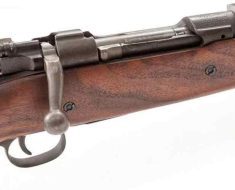Precision and accuracy at your fingertips.
How to Properly Adjust Your Rifle Sights
Rifle sights are an essential component of any firearm, as they help shooters aim accurately and hit their target with precision. Properly adjusting your rifle sights is crucial to ensure that your shots are on target and that you are getting the most out of your firearm. In this article, we will discuss the importance of adjusting your rifle sights, as well as provide you with some tips on how to do so effectively.
When it comes to rifle sights, there are two main types: iron sights and optical sights. Iron sights are the traditional type of sights that are built into the firearm itself, while optical sights, such as scopes, use lenses to magnify the target and provide a clearer view. Regardless of the type of sight you are using, it is important to make sure that they are properly aligned and adjusted to ensure accuracy.
One of the most common reasons for needing to adjust your rifle sights is that they may have become misaligned due to bumps or drops. If you notice that your shots are consistently off target, it may be time to adjust your sights. To do this, you will need to make small adjustments to the windage and elevation settings on your sights.
Windage refers to the horizontal adjustment of your sights, while elevation refers to the vertical adjustment. To adjust the windage, you will need to turn the windage knob on your sights in the direction that you want your shots to move. For example, if your shots are consistently hitting to the right of the target, you will need to adjust the windage knob to the left.
Similarly, to adjust the elevation, you will need to turn the elevation knob on your sights in the direction that you want your shots to move. If your shots are consistently hitting low, you will need to adjust the elevation knob up. It is important to make small adjustments and test your shots after each adjustment to ensure that you are moving in the right direction.
When adjusting your rifle sights, it is important to remember that every firearm is different, and what works for one gun may not work for another. It may take some trial and error to find the perfect settings for your particular firearm, so be patient and persistent in your adjustments.
If you are having trouble adjusting your rifle sights on your own, it may be helpful to seek the assistance of a professional gunsmith. Gunsmiths have the knowledge and expertise to properly align and adjust rifle sights, ensuring that your shots are on target every time.
In conclusion, properly adjusting your rifle sights is essential to ensure accuracy and precision when shooting. By understanding the importance of alignment and making small adjustments to your windage and elevation settings, you can improve your shooting accuracy and hit your target with confidence. Remember to be patient and persistent in your adjustments, and don’t hesitate to seek the help of a professional if needed. With the right adjustments, you can make the most out of your rifle sights and become a more skilled shooter.
Importance of Aligning Your Rifle Sights
When it comes to shooting accurately with a rifle, proper alignment of your sights is crucial. Whether you are a seasoned marksman or a beginner just getting started, understanding how to align your rifle sights can make a significant difference in your shooting accuracy. In this article, we will discuss the importance of aligning your rifle sights, as well as how to adjust and repair them if needed.
Rifle sights are designed to help you aim your weapon accurately at your target. There are two main types of rifle sights: iron sights and optical sights. Iron sights consist of a front sight post and a rear sight aperture, while optical sights use a scope to magnify the target. Regardless of the type of sight you are using, proper alignment is essential for hitting your target consistently.
When your rifle sights are not properly aligned, your shots will not hit where you are aiming. This can be frustrating and lead to missed opportunities in the field or at the range. By taking the time to align your sights correctly, you can improve your shooting accuracy and increase your confidence as a shooter.
To align your rifle sights, start by ensuring that the front sight post is centered in the rear sight aperture. This will help you establish a consistent sight picture each time you aim your rifle. Next, adjust the elevation and windage settings on your sights to zero them in on your target. This may require some trial and error, so be patient and make small adjustments until you are hitting your target consistently.
If you find that your rifle sights are still not aligned properly, it may be time to make some adjustments. Most iron sights can be adjusted using a screwdriver or other tools, while optical sights may require more specialized equipment. Consult your rifle’s manual or a professional gunsmith for guidance on how to make the necessary adjustments.
In some cases, your rifle sights may become damaged or worn out and need to be repaired or replaced. If you notice that your sights are loose, crooked, or otherwise not functioning correctly, it is important to address the issue promptly. A damaged sight can affect your shooting accuracy and potentially be dangerous if not fixed.
When repairing or replacing your rifle sights, be sure to use high-quality parts and follow the manufacturer’s instructions carefully. If you are unsure of how to proceed, seek the help of a qualified gunsmith who can assist you with the repair or replacement process.
In conclusion, aligning your rifle sights is a critical step in shooting accurately and consistently. By taking the time to ensure that your sights are properly aligned, you can improve your shooting skills and increase your success in the field or at the range. If you encounter any issues with your rifle sights, don’t hesitate to make the necessary adjustments or repairs to keep your weapon in top condition. With a little time and effort, you can enjoy improved shooting accuracy and confidence as a rifle shooter.
Common Issues with Rifle Sights and How to Repair Them
Rifle sights are an essential component of any firearm, as they help shooters aim accurately and hit their targets with precision. However, like any mechanical device, rifle sights can experience issues that affect their performance. In this article, we will discuss some common problems with rifle sights and how to repair them.
One of the most common issues with rifle sights is misalignment. This can occur due to a variety of reasons, such as improper installation, rough handling, or simply wear and tear over time. Misaligned rifle sights can cause shots to miss the target, leading to frustration for the shooter.
To fix misaligned rifle sights, the first step is to ensure that the sights are properly installed on the firearm. Check for any loose screws or other signs of instability. If everything looks secure, the next step is to adjust the sights themselves. Most rifle sights have windage and elevation adjustments that allow shooters to fine-tune their aim. Use a sight adjustment tool or a small screwdriver to make the necessary adjustments, being careful not to over-tighten or strip the screws.
Another common issue with rifle sights is damage to the sight itself. This can happen if the rifle is dropped or bumped against a hard surface, causing the sight to become bent or broken. In some cases, the damage may be minor and only require a simple repair. However, if the sight is severely damaged, it may need to be replaced entirely.
To repair a damaged rifle sight, start by assessing the extent of the damage. If the sight is only slightly bent, you may be able to gently bend it back into place using a pair of pliers or a similar tool. Be careful not to apply too much force, as this can cause further damage. If the sight is broken or cannot be repaired, it will need to be replaced. Contact the manufacturer or a qualified gunsmith to find a suitable replacement sight for your firearm.
One final issue that shooters may encounter with rifle sights is poor visibility. This can be caused by a variety of factors, such as dirt or debris obstructing the sight picture, or a lack of contrast between the sight and the target. Poor visibility can make it difficult to aim accurately and hit the target consistently.
To improve visibility with rifle sights, start by cleaning the sights thoroughly with a soft cloth and a mild cleaning solution. Remove any dirt, oil, or other debris that may be obstructing the sight picture. If visibility is still an issue, consider adding a sight enhancer or paint to the sights to increase contrast and make them easier to see in different lighting conditions.
In conclusion, rifle sights are a crucial component of any firearm, and it is important to keep them in good working condition to ensure accurate shooting. By addressing common issues such as misalignment, damage, and poor visibility, shooters can maintain their rifle sights and enjoy improved accuracy on the range or in the field. Remember to handle your firearm with care and seek professional help if you are unsure how to repair a problem with your rifle sights.
Different Types of Rifle Sights and Their Pros and Cons
When it comes to rifle sights, there are several different types to choose from, each with its own set of pros and cons. Understanding the differences between these sights can help you make an informed decision about which one is best for your shooting needs.
One of the most common types of rifle sights is the iron sight. Iron sights are simple, durable, and reliable, making them a popular choice among many shooters. They consist of a front sight post and a rear sight aperture, which are aligned to help you aim accurately at your target. One of the main advantages of iron sights is that they do not require batteries or any other external power source, making them a low-maintenance option for many shooters. However, iron sights can be more challenging to use in low-light conditions or at longer distances, as they do not provide the same level of precision as some other types of sights.
Another popular type of rifle sight is the red dot sight. Red dot sights use a red dot or reticle to help you aim at your target. These sights are easy to use and provide quick target acquisition, making them a great option for fast-paced shooting situations. Red dot sights are also effective in low-light conditions, as the red dot is easy to see even in dim lighting. However, red dot sights can be more expensive than iron sights, and they require batteries to operate, which can be a drawback for some shooters.
A third type of rifle sight is the holographic sight. Holographic sights use a holographic reticle to help you aim at your target. These sights are similar to red dot sights in that they provide quick target acquisition and are effective in low-light conditions. However, holographic sights are typically more expensive than red dot sights, and they can be more fragile, making them less durable in some situations.
One of the newest types of rifle sights is the reflex sight. Reflex sights use a reflective lens to project a reticle onto the target, allowing you to aim accurately without having to align front and rear sights. Reflex sights are easy to use and provide quick target acquisition, making them a popular choice among many shooters. However, reflex sights can be more expensive than iron sights, and they may not be as precise at longer distances.
In conclusion, there are several different types of rifle sights to choose from, each with its own set of pros and cons. Iron sights are simple, durable, and reliable, but may be more challenging to use in low-light conditions or at longer distances. Red dot sights provide quick target acquisition and are effective in low-light conditions, but can be more expensive and require batteries. Holographic sights offer quick target acquisition and are effective in low-light conditions, but may be more fragile and expensive. Reflex sights provide quick target acquisition and are easy to use, but may be more expensive and less precise at longer distances. Ultimately, the best type of rifle sight for you will depend on your shooting needs and preferences.
Tips for Maintaining and Cleaning Your Rifle Sights
Rifle sights are an essential component of any firearm, as they help shooters aim accurately and hit their targets with precision. Proper maintenance and cleaning of rifle sights are crucial to ensure they function effectively and accurately. In this article, we will discuss some tips for maintaining and cleaning your rifle sights to keep them in top condition.
One of the most important aspects of maintaining rifle sights is regular inspection and adjustment. Over time, rifle sights can become misaligned due to recoil, rough handling, or other factors. It is essential to check the alignment of your rifle sights regularly and make any necessary adjustments to ensure they are properly aligned for accurate shooting.
To adjust rifle sights, you will need a sight adjustment tool or a small screwdriver, depending on the type of sights on your rifle. Most rifle sights have windage and elevation adjustments that allow you to move the sight left or right and up or down to align it with your target. Follow the manufacturer’s instructions for adjusting your specific type of rifle sights, and make small adjustments at a time to avoid overcorrecting.
In addition to regular inspection and adjustment, cleaning your rifle sights is also essential for maintaining their accuracy and longevity. Dirt, dust, and debris can accumulate on rifle sights over time, affecting their visibility and performance. To clean your rifle sights, use a soft, lint-free cloth to wipe away any dirt or residue from the sight surfaces. Avoid using harsh chemicals or abrasive materials that could damage the sights.
For stubborn dirt or residue, you can use a small amount of gun cleaning solvent on a cloth to gently clean the sights. Be sure to wipe away any excess solvent and dry the sights thoroughly to prevent rust or corrosion. Regular cleaning of your rifle sights will help maintain their clarity and ensure they function properly when you need them most.
Another important aspect of maintaining rifle sights is protecting them from damage during storage and transportation. When not in use, store your rifle in a secure, dry location to prevent dust, moisture, or other contaminants from affecting the sights. Use a protective case or cover to shield the sights from bumps, scratches, or other damage during transportation.
If your rifle sights become damaged or malfunction, it is essential to have them repaired by a qualified gunsmith or firearms technician. Attempting to repair or adjust damaged rifle sights yourself can result in further damage or misalignment, affecting the accuracy of your shooting. Trusting a professional to repair your rifle sights will ensure they are properly fixed and aligned for optimal performance.
In conclusion, maintaining and cleaning your rifle sights is essential for ensuring they function effectively and accurately. Regular inspection, adjustment, and cleaning of rifle sights will help maintain their alignment, clarity, and performance for years to come. By following these tips for maintaining and cleaning your rifle sights, you can enjoy accurate shooting and hit your targets with precision every time.





